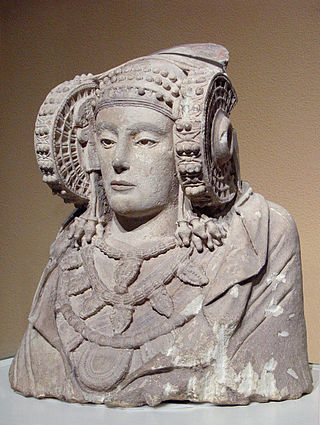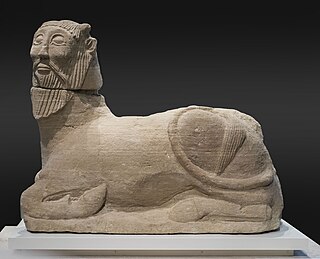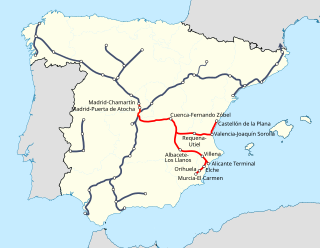
Castilla–La Mancha is an autonomous community of Spain. Comprising the provinces of Albacete, Ciudad Real, Cuenca, Guadalajara and Toledo, it was created in 1982. It takes its name from those of the historical regions of Castile (Castilla) and La Mancha. The government headquarters are in Toledo, which is the capital de facto.

Albacete is a province of central Spain, in the southern part of the autonomous community of Castile–La Mancha. As of 2012, Albacete had a population of 402,837 people. Its capital city, also called Albacete, is 262 kilometres (163 mi) by road southeast of Madrid.

The Lady of Elche is a limestone bust that was discovered in 1897, at La Alcudia, an archaeological site on a private estate two kilometers south of Elche, Spain. It is now exhibited in the National Archaeological Museum of Spain in Madrid.

Albacete is a city and municipality in the Spanish autonomous community of Castilla–La Mancha, and capital of the province of Albacete.

The Oretani or Oretanii were a pre-Roman ancient Iberian people of the Iberian Peninsula, that lived in northeastern Andalusia, in the upper Baetis (Guadalquivir) river valley, eastern Marianus Mons, and the southern area of present-day La Mancha.

The Contestani were an ancient Iberian (Pre-Roman) people of the Iberian peninsula. They are believed to have spoken the Iberian language.

Hellín is a city and municipality of Spain located in the province of Albacete, Castilla–La Mancha. The municipality spans across a total area of 781.66 km2. As of 1 January 2020, it has a population of 30,200, which makes it the second largest municipality in the province. It belongs to the comarca of Campos de Hellín.

The National Archaeological Museum is a museum in Madrid, Spain. It is located on Calle de Serrano beside the Plaza de Colón, sharing its building with the National Library of Spain.

Alcaraz is a municipality of Spain located in the province of Albacete, Castilla–La Mancha. The municipality spans across a total area of 370.53 km2. The locality lies at 953 metres above mean sea level.

Bogarra is a municipality in Albacete, Castilla-La Mancha, Spain. It has a population of 1,235. The town is approximately 78 km from the main city of Albacete.

The motillas were the early settlements of La Mancha (Spain) belonging to the Middle Bronze Age, and connected to the Bronze of Levante culture. These were human-made hills atop of which are placed fortified settlements. Their height is usually between four and five meters and the motillas are separated from each other by a distance of four to five kilometers. Their construction started c. 2200 BCE and they were used for about 1000 years.

The Bicha of Balazote is an Iberian sculpture that was found in the borough of Balazote in Albacete province, Spain. Carlos Fuentes has called it the "Beast of Balazote." The sculpture has been dated to the 6th century BCE, and has been in the National Archaeological Museum of Spain in Madrid, since 1910.

Iberian sculpture, a subset of Iberian art, describes the various sculptural styles developed by the Iberians from the Bronze Age up to the Roman conquest. For this reason it is sometimes described as Pre-Roman Iberian sculpture.
The Consejo Superior de los Colegios de Arquitectos de España (CSCAE), is the higher council of Architects Associations in Spain, and is the only established professional body of Spanish architects, located in the Paseo de la Castellana, Madrid.

Castilla-La Mancha Fútbol Sala was a futsal club based in Talavera de la Reina, Castile-La Mancha. Castilla-La Mancha was one of the most important futsal clubs from Spain.

Antonio Gómez Pérez is a Spanish retired footballer who played as a midfielder, currently a manager.

The Madrid–Levante high-speed network is a network of high-speed rail lines that connects Madrid with the Mediterranean coast of the Levante Region, specifically with Castilla-La Mancha, the Valencian Community and the Murcia Region autonomous communities.

The 38th Federal Congress of the Spanish Socialist Workers' Party was held in Seville from 3 to 5 February 2012, to renovate the governing bodies of the Spanish Socialist Workers' Party (PSOE) and establish the party's main lines of action and strategy for the next leadership term. The congress was called after the PSOE suffered its worst defeat since the Spanish transition to democracy in the general election held on 20 November 2011. Previous secretary-general José Luis Rodríguez Zapatero had announced in April the same year he would not stand for election to a third term as Prime Minister of Spain, announcing his intention to step down as party leader after a successor had been elected.

Carmina Useros Cortés was a Spanish writer, ceramist, painter, and cultural manager. A researcher of the gastronomic, artisan, and cultural traditions of Albacete, she was one of the first women gastronomes in Spain.

Gregorio Jiménez Tornero, known professionally as Goyo Jiménez, is a Spanish actor, screenwriter and humorist known for his stand-up comedy performances.


















